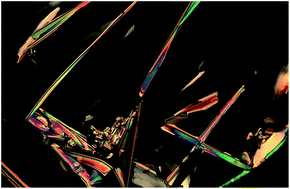Intramolecular Diels Alder reactions in highly organized imidazolium salt-based ionic liquid crystals†
Abstract
This paper describes the development of a new family of ionic liquid crystals based on imidazolium salts and their applications as media for intramolecular Diels Alder reactions. The use of highly organized smectic T phases was shown to be an efficient method to obtain the intramolecular Diels Alder product in high yields, without using high dilution conditions. The ionic liquid crystal media can be recycled in an easy procedure and reused up to at least five times, without loss of reactivity and selectivity.


 Please wait while we load your content...
Please wait while we load your content...